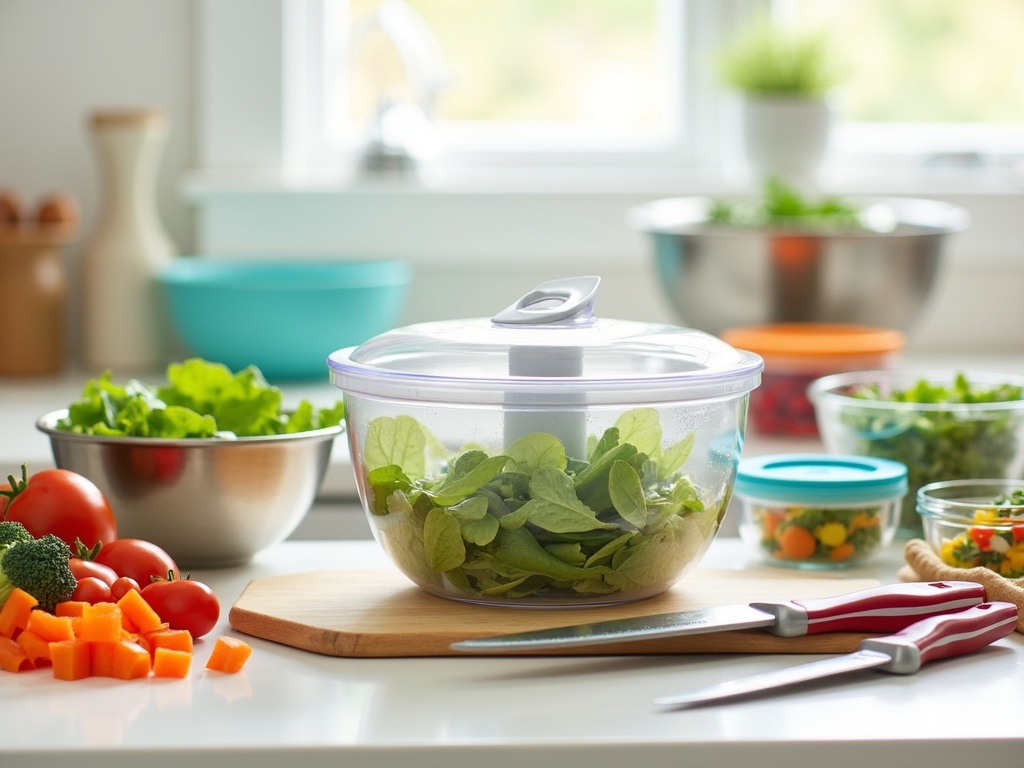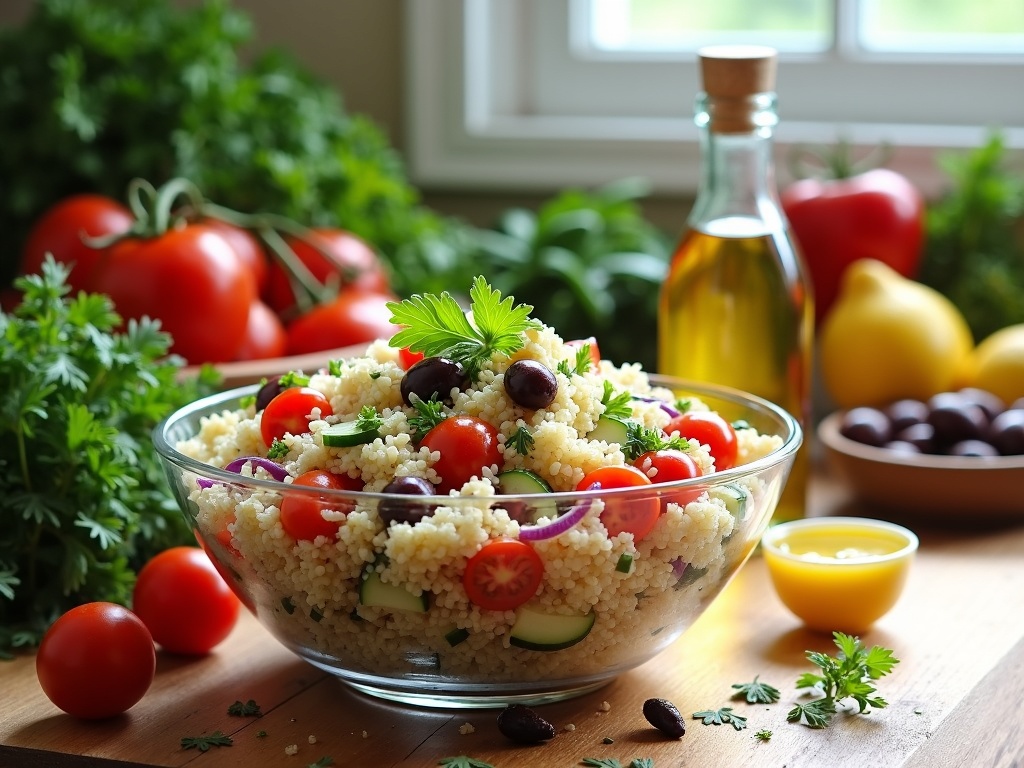I find homemade healthy salad recipes superior to store-bought options in nutrition, cost, and ingredient control. Fresh components deliver maximum nutrients while letting me customize based on my tastes and dietary requirements.
Find In This Article
Key Takeaways
- Homemade salads are significantly more cost-effective, with ingredients typically costing $3-5 per serving versus $8-12 for pre-packaged options.
- Proper preparation techniques, including drying greens thoroughly and adding dressing just before serving, help maintain optimal texture and flavor.
- Creating balanced salads requires combining proteins, healthy fats, complex carbohydrates, and fresh vegetables for complete nutrition.
- Batch preparation of components like pre-cooked grains, proteins, and chopped vegetables can make healthy eating effortless throughout busy weeks.
- Essential tools like a salad spinner, sharp knives, and proper storage containers dramatically improve salad quality and preparation efficiency.
Why Making Your Own Salads Matters
I’ve discovered that preparing my own salads has completely transformed my approach to healthy eating. When I first started making healthy recipes at home, I noticed immediate benefits that went beyond just eating more greens.
Health Benefits and Cost Savings
The nutritional advantages of homemade salads are significant. When I prepare a vibrant watermelon feta salad or a hearty sweet potato salad, I’m getting fresh ingredients with maximum nutrients. Store-bought salads often sit on shelves for days, losing valuable vitamins and minerals with each passing hour.
Making salads at home also makes financial sense. I’ve calculated that a pre-packaged salad from the grocery store can cost $8-12, while the ingredients for a homemade version might total $3-5 per serving. This saving adds up quickly when eating salads several times a week. For example, making a simple green bean salad at home costs a fraction of its pre-made counterpart.
The control over ingredients is perhaps the most valuable aspect of making salads at home. I can:
- Avoid unnecessary additives and preservatives found in commercial salad dressings
- Select organic produce when it matters most
- Adjust portions based on my hunger level or nutritional needs
- Incorporate seasonal produce for peak flavor and nutrition
- Customize flavors to my exact preferences
I find this especially important when preparing fruit salad recipes where store versions often contain added sugars or syrups. When I make my own, I can let the natural sweetness of the fruits shine through.
The quality difference is clear too. I’ve noticed the crispness of lettuce and the juiciness of a mango salad can’t be matched by pre-packaged options. When I prepare salads myself, I can ensure each ingredient is at its peak ripeness and freshness.
The creative aspect shouldn’t be overlooked either. I’ve found joy in experimenting with different combinations – trying new grains, proteins, or dressing variations. This freedom to explore has led me to discover flavor pairings I wouldn’t have encountered with limited store options.
Making my own salads has also helped me develop better eating habits overall. I’ve become more mindful about what goes into my body and more appreciative of simple, natural ingredients. The process of washing, chopping, and assembling has become a relaxing ritual rather than a chore.
For anyone concerned about time constraints, I’ve found that batch preparation works wonders. Washing and chopping vegetables once can provide the foundation for several days of salads. Even spending 30 minutes on a Sunday preparing ingredients can make healthy eating effortless throughout the busy week.
The environmental impact is worth considering too. By purchasing whole produce and avoiding single-use plastic containers, I’ve significantly reduced the packaging waste associated with my meals.
Taking control of my salad preparation has proven to be a small change with big impacts on my health, wallet, and culinary satisfaction. The versatility and customization possible with homemade salads continue to make them a cornerstone of my healthy eating approach.
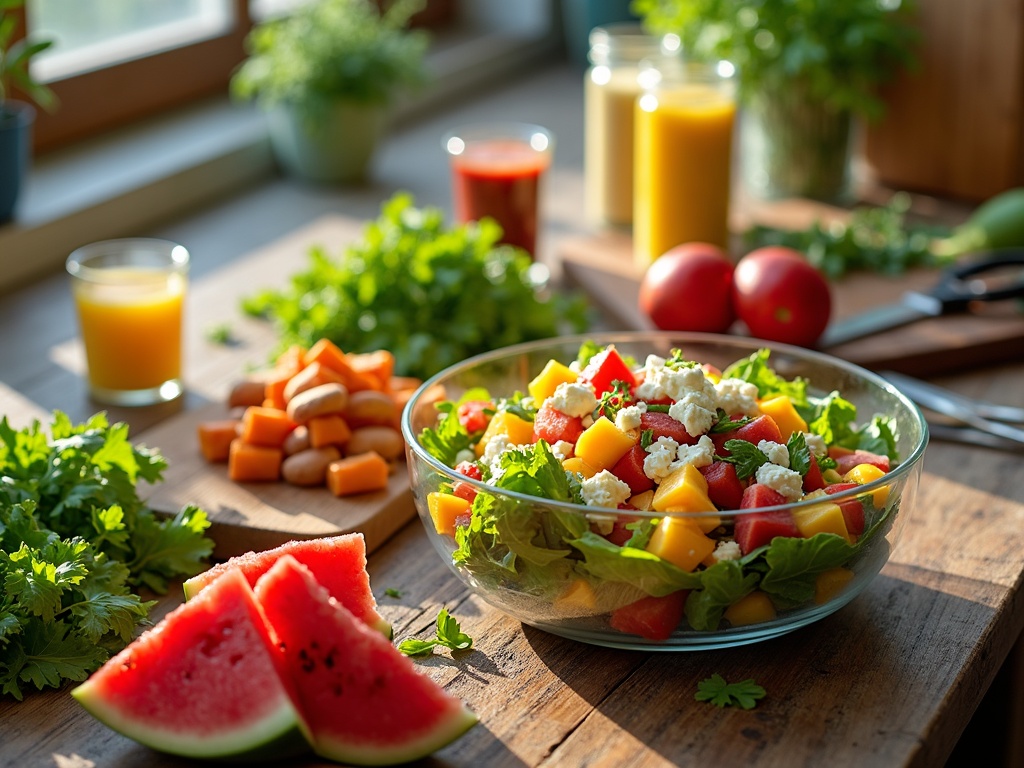
Fresh and Vibrant Mediterranean Quinoa Salad
I’ve found that a good Mediterranean quinoa salad strikes the perfect balance between nutrition and flavor. This colorful dish combines protein-packed quinoa with fresh vegetables and herbs for a meal that’s both satisfying and energizing.
Building the Perfect Mediterranean Bowl
Quinoa forms an excellent base for this salad because it provides complete protein while remaining light and fluffy. After cooking the quinoa, I always let it cool completely before mixing it with other ingredients to maintain the ideal texture.
The vibrant mix of vegetables brings this dish to life. I dice cherry tomatoes for bursts of sweetness, crisp cucumber for refreshing crunch, and thinly sliced red onion for a gentle bite. These classic Mediterranean ingredients create a colorful foundation that’s as appealing to the eye as it is to the palate.
For that authentic Mediterranean flavor, I incorporate creamy feta cheese and briny Kalamata olives. The feta adds richness while the olives contribute a distinctive tangy depth that makes this salad memorable. This combination creates the perfect contrast to the fresh vegetables.
Fresh herbs are essential to elevating this dish. Chopped parsley adds a clean, bright flavor while mint contributes a cooling element that makes the salad especially refreshing on warm days. These herbs don’t just add color – they transform the entire flavor profile of the salad.
The dressing ties everything together with its simple yet powerful combination of ingredients. I whisk together fresh lemon juice and extra virgin olive oil with a touch of salt and pepper. This straightforward dressing allows the natural flavors of the ingredients to shine without overwhelming them.
This Mediterranean quinoa salad works beautifully as a standalone lunch or as a side dish with grilled protein. For variety, you might consider adding roasted red peppers or complementing it with a watermelon feta salad for a complete Mediterranean-inspired meal.
The beauty of this salad lies in its versatility – it can be prepared ahead of time and actually improves as flavors meld together. For a heartier variation, consider adding chickpeas or pairing it with a sweet potato salad for a more substantial meal that still maintains its healthy profile.
Step-by-Step Preparation
Mastering the art of salad preparation is all about technique and timing. I’ve found that getting each component right creates a truly exceptional healthy salad that’s both visually appealing and delicious.
Creating the Perfect Foundation
Cooking quinoa properly forms the base of many nutritious salads. I start by rinsing the quinoa thoroughly under cold water to remove its bitter coating called saponin. For perfect fluffy quinoa, I use a 1:2 ratio of quinoa to water, bringing it to a boil then simmering covered for about 15 minutes until the liquid is absorbed. After cooking, I fluff it with a fork and let it cool completely before adding it to my sweet potato salad with quinoa or other grain-based creations.
Chopping vegetables uniformly isn’t just about aesthetics—it ensures even distribution of flavors and textures. I use a sharp knife to dice vegetables into similar-sized pieces. For ingredients like cucumbers and tomatoes in a watermelon feta salad, I aim for consistent half-inch cubes. For leafy greens, I tear rather than cut to prevent browning at the edges.
When mixing ingredients, I follow these key steps:
- Combine hearty ingredients first (grains, proteins, root vegetables)
- Add delicate items next (leafy greens, herbs, soft fruits)
- Toss gently using two large spoons or salad servers to prevent crushing
- Season gradually, tasting as you go
I’ve learned that timing is crucial when adding dressing. For maximum freshness, I dress my green bean salad or mango salad just before serving. This prevents soggy greens and maintains the perfect texture. For make-ahead options, I keep components separate and assemble just before eating.
When working with fruit-based salads, I apply a light coating of lemon juice to prevent browning, especially in recipes like my fruit salad recipe that features apples or pears.
For meal-prep situations, I layer ingredients strategically—dressing at the bottom, hearty vegetables next, proteins in the middle, and delicate greens on top. This keeps everything fresh until lunchtime.
By following these preparation techniques, I’ve created countless healthy recipes that are both satisfying and nutritious. The key is patience and attention to detail, ensuring each ingredient shines while contributing to a harmonious whole.
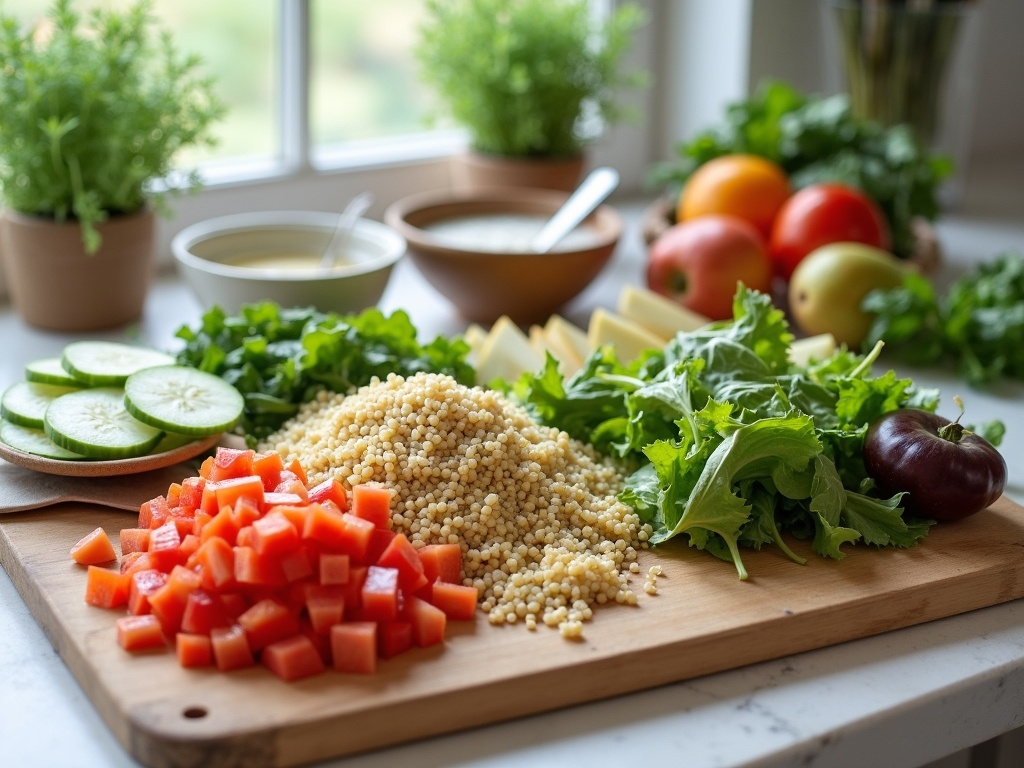
Crunchy Asian-Inspired Slaw
When I’m looking for a refreshing salad with texture and flavor, this Crunchy Asian-Inspired Slaw never disappoints. It’s packed with vibrant vegetables, protein, and a zingy dressing that brings everything together beautifully.
Fresh Ingredients and Simple Preparation
The foundation of this slaw starts with a colorful mix of vegetables. I combine thinly shredded purple and green cabbage to create a gorgeous base with plenty of crunch. Carrots julienned into thin strips add a touch of sweetness and bright orange color that makes the salad visually appealing. The cabbage and carrot combination provides an excellent source of vitamins A and C, plus fiber that keeps you feeling satisfied.
For protein and extra texture, I add shelled edamame beans and thinly sliced sugar snap peas. The edamame contributes a good dose of plant-based protein, making this healthy recipe substantial enough to serve as a light meal. The snap peas provide an additional layer of crunch and fresh green flavor that complements the green bean elements in the dish.
What really makes this slaw special is the sesame ginger dressing. I whisk together rice vinegar, a small amount of honey, toasted sesame oil, fresh grated ginger, and a dash of soy sauce. This combination creates a perfect balance of tangy, sweet, and savory flavors that coat each vegetable perfectly. The aromatic qualities of the ginger and sesame oil give this salad recipe its distinctly Asian-inspired profile.
Just before serving, I top the slaw with a generous sprinkle of crushed peanuts for added crunch and nutty flavor. For a hint of freshness, a scatter of chopped cilantro and green onions works beautifully. You can also include some mango chunks for a tropical twist, creating a flavor profile similar to popular summer salads but with an Asian flair.
This slaw stores well in the refrigerator for up to two days, though the vegetables will soften slightly over time. For the best texture, I recommend adding the dressing and toppings just before serving. It’s a versatile side dish that pairs wonderfully with grilled chicken or fish, or can be enjoyed as a light and satisfying lunch on its own.
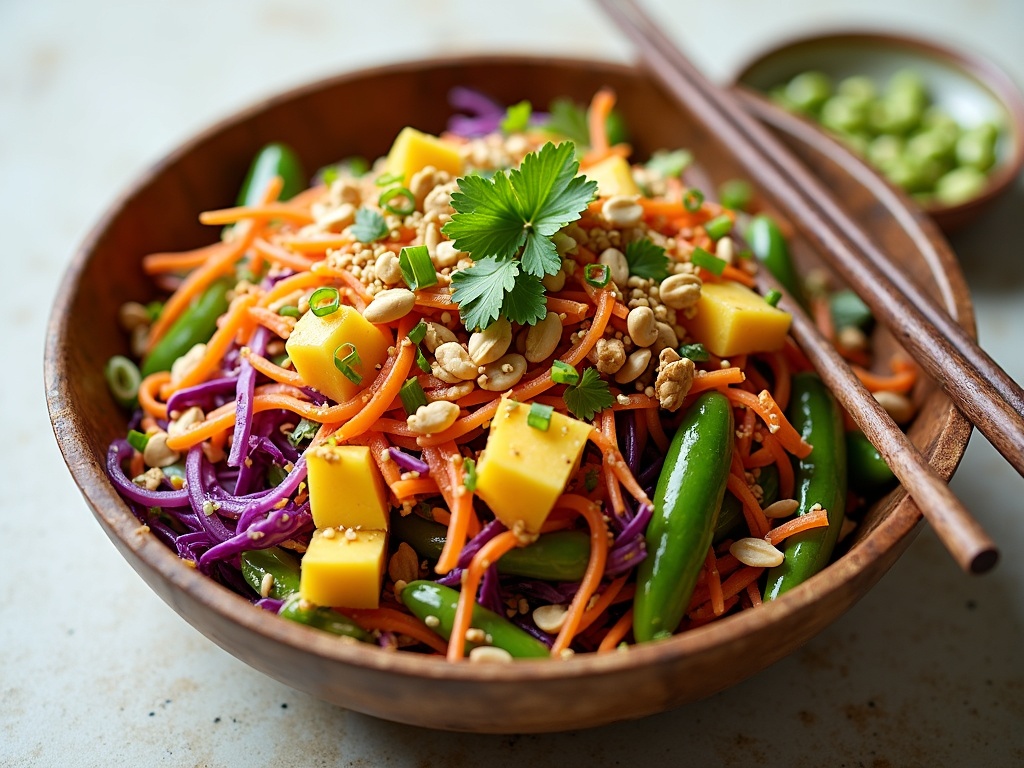
Creating the Perfect Balance
The key to a truly satisfying salad lies in achieving the perfect balance of nutrients. When I create salads at home, I focus on combining proteins, healthy fats, complex carbohydrates, and a variety of fresh vegetables to ensure my meal isn’t just delicious but also nutritionally complete.
Building Blocks of a Balanced Salad
Protein adds staying power to any salad, keeping hunger at bay for hours after eating. I like to incorporate these protein options:
- Grilled chicken breast (3-4 ounces per serving)
- Hard-boiled eggs (1-2 per salad)
- Chickpeas or black beans (½ cup adds about 7g protein)
- Grilled salmon or tuna (4 ounces)
- Tofu or tempeh (marinated for extra flavor)
Healthy fats are essential for nutrient absorption and satisfaction. I drizzle my green bean salad with olive oil or add sliced avocado to provide those necessary fats. A handful of nuts or seeds can transform a basic watermelon and feta salad into something substantial.
Complex carbohydrates bring energy and fiber to the mix. I regularly include:
- Quinoa or brown rice (½ cup cooked)
- Sweet potatoes (roasted cubes add beautiful color to a sweet potato salad)
- Whole grain croutons or torn whole wheat pita
- Corn kernels (fresh or roasted)
- Barley or farro for hearty texture
Fresh vegetables provide the foundation with vital nutrients and vibrant colors. I aim for at least 3-4 different vegetables in each salad to maximize nutritional benefits. A mango salad gets extra crunch from bell peppers and cucumbers, while leafy greens offer different phytonutrients depending on the variety you choose.
The magic happens when these elements come together. For instance, a Mediterranean-inspired bowl might combine quinoa, chickpeas, cucumber, tomatoes, olives, and a lemon-tahini dressing. Or try a tropical variation with brown rice, grilled chicken, fresh fruit combinations, avocado, and a citrus vinaigrette.
I’ve found that keeping these components on hand makes it easy to create healthy recipes on busy weeknights. Pre-cooked grains, canned beans (rinsed well), and prepared proteins can be mixed with fresh produce for quick, nutritious meals.
By thinking about balance rather than restriction, salads transform from diet food to satisfying meals that fuel your body and please your palate. The perfect balance ensures you’re getting all the nutrients you need while creating flavors that keep you coming back for more.
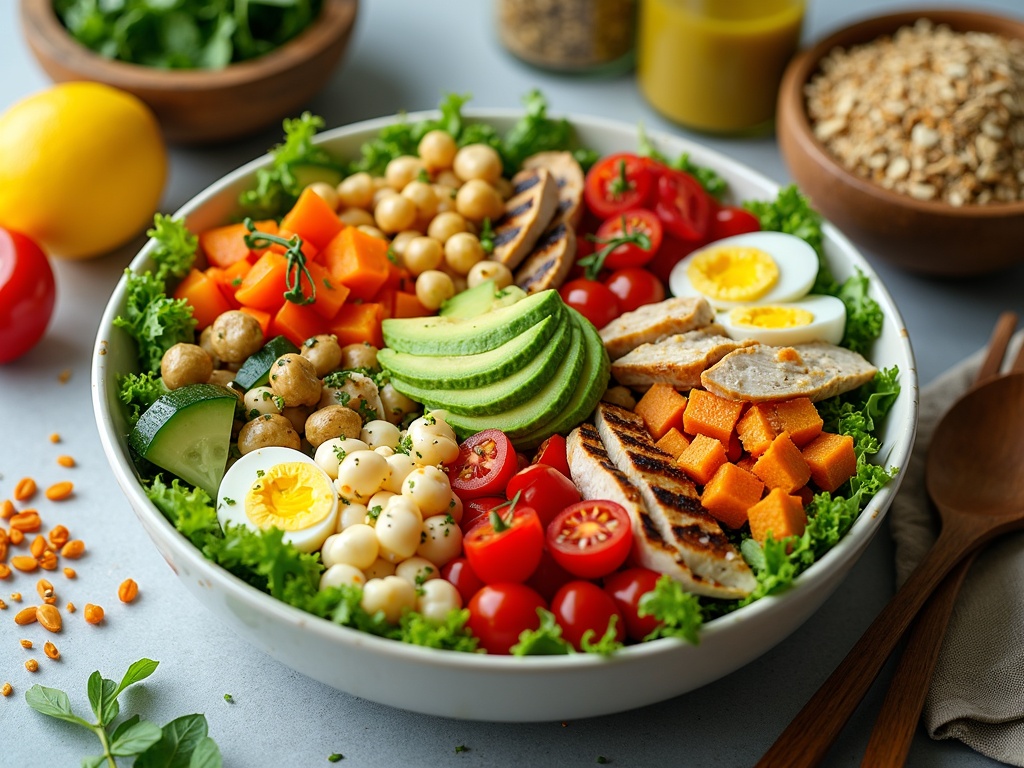
Common Salad Making Mistakes
Creating the perfect salad seems straightforward, yet there are several pitfalls that can turn your nutritious meal into a soggy disappointment. I’ve identified some frequent errors that home cooks make when preparing salads and how to avoid them for consistently delicious results.
Overdressing and Improper Preparation
Drowning your greens in dressing is perhaps the most common mistake I see in salad preparation. When too much dressing is added, the crisp vegetables become limp and the flavors become overwhelmed. Instead, I recommend using the “less is more” approach—start with a small amount and add more if needed. A good rule of thumb is about one tablespoon of dressing per two cups of greens.
Another crucial mistake is not drying your ingredients properly after washing. Excess water dilutes the dressing and creates a watery pool at the bottom of your bowl. This is particularly important when making options like green bean salad where excess moisture can ruin the texture. To avoid this:
- Pat greens dry with paper towels after washing
- Use a salad spinner to remove excess water
- Allow washed vegetables to air dry before assembly
- Drain canned ingredients thoroughly
The timing of when you add dressing matters too. For hearty salads like sweet potato salad, dressing can be added earlier as the ingredients won’t wilt. However, for delicate greens, dress just before serving to maintain crispness.
Imbalanced Ingredients and Poor Quality Produce
Getting the right balance of ingredients is an art that many home cooks struggle with. A common issue is adding too many competing flavors or textures. For example, in a watermelon feta salad, the sweetness of fruit needs to be balanced with just the right amount of salty cheese and tangy dressing.
When proportions are off, one ingredient can dominate and mask the others. I find these guidelines helpful:
- Balance textures (crunchy, soft, chewy)
- Mix flavors (sweet, salty, sour, bitter)
- Create visual appeal with different colors
- Consider the role of each ingredient (base, protein, accent flavors)
Using wilted or poor-quality produce is another critical mistake. Fresh ingredients are the foundation of any great salad. When I make a mango salad, selecting perfectly ripe mangoes makes all the difference in the final dish.
Signs of poor-quality produce to avoid include:
- Browning or discoloration on the edges of greens
- Soft spots on fruits and vegetables
- Dull appearance rather than vibrant color
- Strong or off-putting smell
The temperature of ingredients also impacts salad quality. Cold ingredients generally taste fresher, which is why I chill components before assembling a fruit salad recipe. However, room temperature tomatoes offer better flavor than refrigerated ones.
Lastly, many cooks overlook the importance of proper cutting techniques. Inconsistent sizes make eating difficult and affect how flavors blend. For tender greens, tear rather than cut to prevent bruising. For harder vegetables, uniform cutting ensures even texture throughout the dish.
By avoiding these common mistakes, your salads will consistently turn out fresh, flavorful and appealing. Looking for more guidance? Check out my collection of healthy recipes for inspiration on creating balanced, nutritious meals that don’t sacrifice on taste.
Smart Prep and Storage Tips
Prepping salads ahead of time has transformed my weekly meal routines. I’ve learned that a few simple techniques can keep my healthy salad ingredients fresh and ready to assemble whenever hunger strikes.
Mastering Salad Prep Essentials
When washing greens, I avoid soaking them directly under running water as this can bruise delicate leaves. Instead, I fill a large bowl with cold water, add the greens, and swish them gently. After letting any dirt settle to the bottom, I lift the greens out and dry them thoroughly using a salad spinner or clean kitchen towels. Excess moisture is the enemy of crisp greens!
Storage containers make a significant difference in keeping ingredients fresh. Glass containers with locking lids create an airtight seal that preserves freshness better than plastic alternatives. For leafy greens specifically, I line containers with paper towels to absorb excess moisture—this simple trick can extend freshness by several days.
Make-ahead components have become my secret weapon for quick meal assembly. Here are the elements I prepare in advance:
- Proteins: Grilled chicken, hard-boiled eggs, or chickpeas stay fresh for 3-4 days when refrigerated properly
- Roasted vegetables: Sweet potatoes for a delicious sweet potato salad or green beans for a vibrant green bean salad can be prepared days ahead
- Dressings: Homemade vinaigrettes stored in mason jars last up to a week
- Fruit: Pre-cut watermelon for watermelon feta salad or mango for refreshing mango salad
Keeping ingredients fresh longer requires understanding their specific needs. Berries for fruit salad recipes last longer when washed just before eating, not during prep. For avocados, I’ve found that brushing cut surfaces with lemon juice prevents browning. Hearty vegetables like carrots and bell peppers maintain their crunch when stored in water in the refrigerator.
I always store prepared salad components separately until serving time. This prevents soggy greens and maintains the distinct textures that make salads enjoyable. For grab-and-go meals, I layer ingredients strategically in mason jars—dressing on the bottom, followed by hearty vegetables, proteins, and greens on top.
With these smart prep and storage methods, I’ve reduced food waste and increased the likelihood of actually eating the healthy salads I plan for the week.
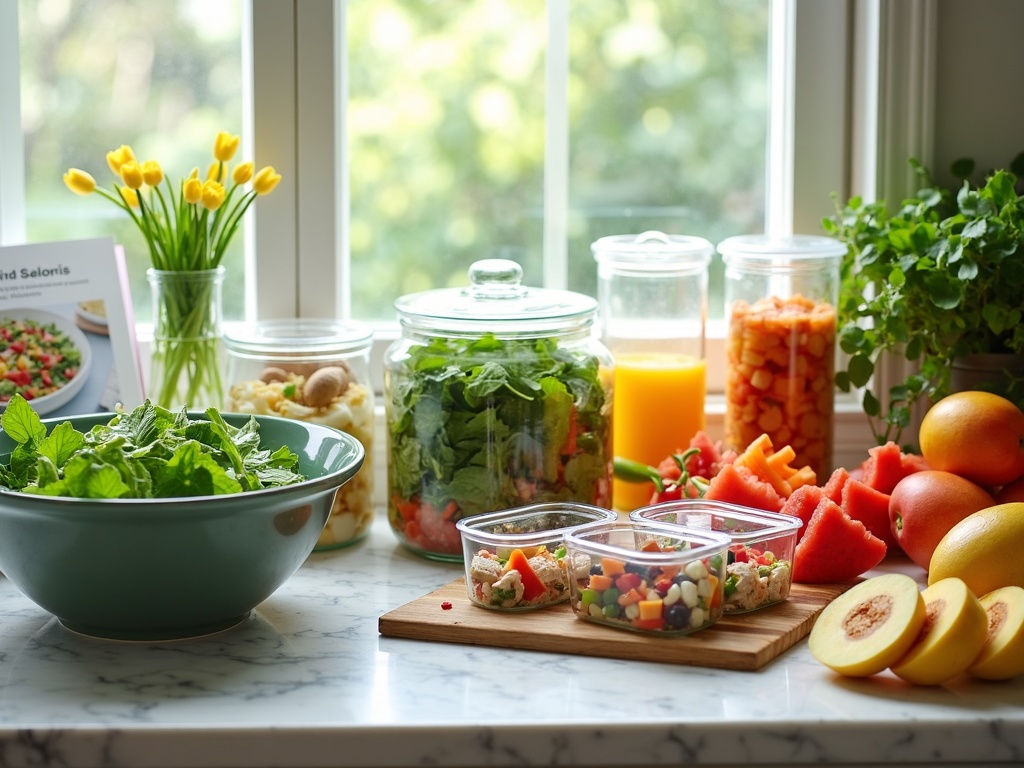
Customization Ideas
Healthy salad recipes become personal masterpieces when you know how to customize them. I’ve discovered that making simple tweaks can transform a basic salad into something extraordinary that fits your exact preferences and dietary needs.
Seasonal Ingredient Swaps
Embracing seasonal produce not only enhances flavor but also ensures you’re getting the freshest nutrients possible. In summer, I love adding juicy tomatoes, cucumbers, and colorful bell peppers to create refreshing combinations like a watermelon feta salad that cools you down on hot days.
When fall arrives, I switch to roasted butternut squash, crisp apples, and dried cranberries. These autumn ingredients pair beautifully with hearty grains like farro or quinoa. Winter calls for heartier options—think roasted root vegetables, Brussels sprouts, and kale that stands up to warmer dressings without wilting.
Spring brings tender greens, asparagus, radishes, and fresh herbs that brighten any green bean salad or light meal. By following what’s naturally in season, you’ll save money and enjoy peak flavors.
Dietary Adaptations and Enhancements
Making salads work for specific dietary needs is simpler than you might think:
For gluten-free diets:
- Replace croutons with toasted nuts or seeds
- Swap farro or wheat berries with quinoa or rice
- Check dressing ingredients for hidden gluten in flavorings or thickeners
For plant-based eaters:
- Add legumes like chickpeas or lentils for protein
- Include nutritional yeast for a cheesy flavor without dairy
- Try avocado-based dressings instead of creamy dairy options
Protein additions elevate any salad from side dish to satisfying meal. Beyond the usual grilled chicken, I recommend trying:
- Marinated tofu cubes (pre-baked for extra firmness)
- Jammy eggs with slightly soft centers
- Flaked canned tuna or salmon for omega-3s
- Roasted chickpeas for plant-based crunch
- Sliced sweet potato salad components for complex carbohydrates
Dressing variations might be the most transformative element. I keep these options in regular rotation:
- Citrus vinaigrettes (lemon, lime, or orange juice with olive oil)
- Tahini-based dressings with garlic and lemon
- Greek yogurt herb dressings for creamy texture with less fat
- Miso-ginger combinations for Asian-inspired salads
The key to perfect dressing is balance—aim for a ratio of 3 parts oil to 1 part acid, then adjust to taste. I always make extra to store in the refrigerator for quick salads throughout the week.
Fruit adds unexpected sweetness to savory salads. Try adding sliced strawberries to spinach salads or incorporate mango salad elements into grain bowls. The contrast between sweet fruit and savory vegetables creates depth that keeps salads interesting.
Temperature contrast creates textural interest too. Warm roasted vegetables atop cool greens wilt them slightly, creating a pleasant contrast. This works particularly well with kale or cabbage-based salads that can handle heat without completely collapsing.
For maximum enjoyment of your fruit salad recipe variations, consider how flavors complement each other. Bitter greens like arugula pair beautifully with sweet elements and rich proteins, while milder lettuces might need bolder dressing and toppings.
With these customization strategies, you’ll discover countless ways to create healthy recipes that never feel repetitive or boring. The best salad is one tailored to your preferences—so experiment freely with these suggestions as your starting point.
Essential Kitchen Tools
Preparing healthy salads becomes significantly easier with the right tools in my kitchen. I’ve found that having a few key implements not only speeds up the process but also improves the quality of my salads. Let’s explore the essential tools that have transformed my salad-making experience.
Preparation Tools
A salad spinner is absolutely indispensable for anyone serious about making crisp, flavorful salads. When I wash leafy greens without properly drying them, dressing slides right off and pools at the bottom of the bowl. The centrifugal force of a spinner removes excess water quickly, allowing dressings to cling properly to leaves. I’ve noticed my green bean salad ingredients maintain their texture much better when thoroughly dried.
Sharp knives are equally important in salad preparation. A dull knife crushes delicate ingredients rather than cleanly slicing through them, which affects both presentation and texture. I recommend having at least:
- A chef’s knife (8-inch) for chopping firm vegetables like carrots and sweet potatoes
- A paring knife for detailed work like hulling strawberries or segmenting citrus for a fruit salad recipe
- A serrated knife for cleanly slicing tomatoes without crushing them
The quality of your knife doesn’t need to break the bank—just ensure it’s kept sharp with regular honing and occasional professional sharpening.
Serving and Storage Solutions
Having a variety of mixing bowl sizes has revolutionized my salad-making process. I use smaller bowls (1-2 quarts) for individual portions or side salads, medium bowls (3-4 quarts) for family meals, and large bowls (5+ quarts) when I’m preparing something like a watermelon feta salad for gatherings.
Materials matter too—I prefer glass bowls for serving and stainless steel for mixing. Glass doesn’t retain odors or stains, while stainless steel is lightweight and durable for tossing ingredients. A wide, shallow bowl shape helps distribute dressings more evenly than deep bowls.
For storage containers, I’ve found that glass containers with locking lids work best for keeping prepared salads fresh. They don’t absorb odors or colors from ingredients like beets in a sweet potato salad. If storing a dressed salad, I use containers with dividers to keep wet ingredients separate until serving time.
The right storage solution also extends to meal prep. I often prepare components for a mango salad in advance, storing chopped ingredients in separate containers to assemble just before eating. This approach maintains freshness and prevents sogginess.
A few additional tools I’ve found valuable include:
- Cutting boards (separate ones for produce and other ingredients)
- Microplane grater for citrus zest and hard cheeses
- Good quality vegetable peeler with a comfortable grip
- Measuring cups and spoons for consistent dressings
Investing in these essential tools has significantly improved my ability to create healthy recipes that are both delicious and visually appealing. The right equipment simplifies preparation, encourages more frequent salad-making, and elevates the final results from ordinary to extraordinary.
